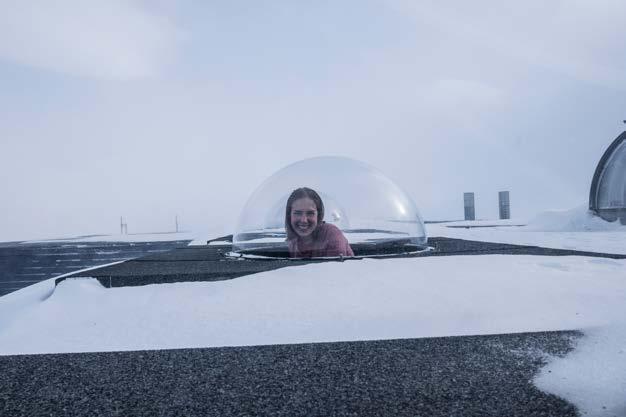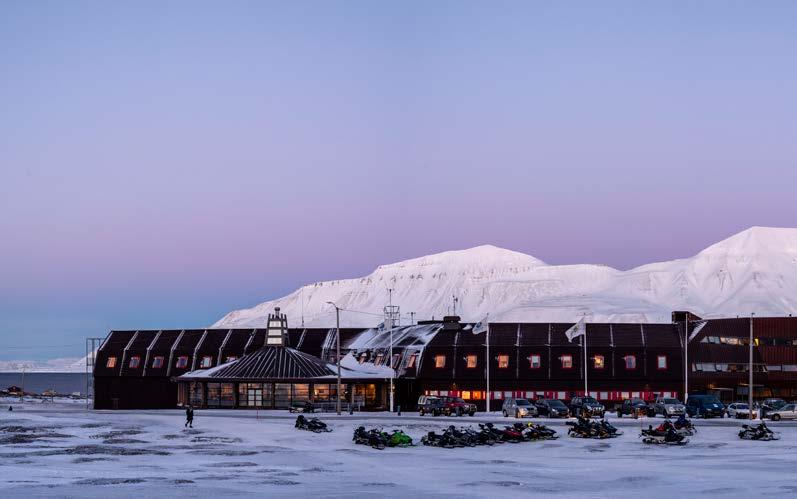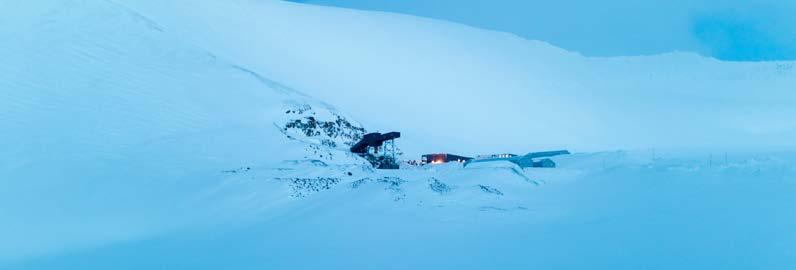
10 minute read
EXCERPT FROM THE BOARD OF DIRECTORS' REPORT 2019
May 2019: The Minister of Research and Higher Education, Ms. Iselin Nybø, visited UNIS and the Kjell Henriksen Observatory (KHO). Here pictured in one of the KHO domes. Photo: Mikko Syrjäsuo/UNIS.
The University Centre in Svalbard AS (UNIS) is a stateowned limited corporation, owned and administered by the Norwegian Ministry of Education and Research. The enterprise’s objective is to provide an educational provision and engage in research based on Svalbard’s geographic location in the High Arctic and the special advantages this offers, by using the nature as a laboratory and arena for observations and collection and analysis of data. The educational provision shall be at university level and act as a supplement to the tuition offered at the universities on the mainland and form part of an ordinary programme of study leading to examinations at bachelor’s, master’s and PhD level.
Advertisement
The educational provision shall have an international profile, and all tuition shall be given in English. There shall be a balance between Norwegian and international students. Through its activities, the enterprise shall contribute to community development in Longyearbyen and Svalbard in line with the overarching objectives of Norwegian Svalbard policy.
EDUCATION AND STUDENT STATISTICS UNIS’ commission from the Ministry of Education and Research for 2019 was to develop an educational provision that represents approximately 220 studentlabour years. In 2019, 743 students spent shorter or longer periods at UNIS, including both course students and guest master’s students. In addition, one guest bachelor’s student and 12 guest PhD students were registered at the institution.
Of the students in 2019, 50% came from programmes of study at Norwegian universities, while the proportion of Norwegian citizens was 32%. The discrepancy between Norwegian citizens and students from Norwegian universities may be attributed to the fact that foreign nationals are admitted to ordinary programmes of study at Norwegian universities. In recent years, UNIS has had a reasonably balanced gender distribution, with a slight predominance of women. The proportion of women has increased in recent years and in 2019 57% of the students were women. UiT – The Arctic University of Norway is the Norwegian university that sends the most students to UNIS, closely followed by the Norwegian University of Science and Technology (NTNU).
A total of 213 student-labour years were produced at UNIS in 2019 (down from 218 in 2018), of which 193 student-labour years were linked to credits (ECTS) from completed courses and 20 student-labour years linked to presence by guest master’s students. The decrease was primarily among bachelor’s degree courses, as production at master’s and PhD level has increase somewhat.

February 2019: UNIS and the Svalbard Science Centre in pink light, indicating the end of the dark season. Photo: Mads Forchhammer/UNIS.
The Department of Arctic Geology experienced the largest decrease in terms of both production and course provision, but still has the highest production and largest educational provision at UNIS. The Department of Arctic Geophysics has a reasonably stable educational provision, but has experienced a decline in production, which may be attributed to the low percentage of places filled on some of the courses. Courses in Arctic Safety are reported for the first time as a separate group and now constitute 9% of the total production at UNIS.
In line with previous years, the results from the final assessment of the courses has been above average, with B as the average grade. The failure percentage has been low (1%).
UNIS had 28 PhD candidates (both internal and external) in 2019, and four public defences were held.
RESEARCH AND ACADEMIC INITIATIVES – EXTERNAL FUNDING In line with UNIS’ new strategy, the institution is developing goals and organisational structures to strengthen research. In 2019, UNIS aimed atlarger and more long-term projects in strategically important areas. This means a more pan-Arctic approach to research issues, while at the same time clarifying UNIS’ corporate social responsibility in Longyearbyen. This requires a clearer and strategic research leadership at UNIS combined with a strengthening of the institution’s research administrative apparatus. In 2019, the Dean of Research and the institution’s Research Committee developed several policies concerning handling of application processes, the use of PhD as strategic measures and a plan for publishing. These have now been sent out for comment within the organisation and will form the basis for the development of a set of rules for research that has now commenced. This is part of the Compliance project at UNIS, and the rules for research are intended to safeguard the processes and legal basis for external project funding, including delegation rules, the TDI full cost model for research infrastructure and contract rules.
UNIS has increased its project portfolio during 2019 and received funding for several major new projects. In 2019, the Department of Arctic Biology (AB) was successful with a major research application (FACE-IT) to the EU’s Horizon 2020, along with Norwegian and international partners. The project is pan-Arctic and AB has a key role in the marine sampling in Svalbard. Furthermore, the Department of Arctic Geology (AG) and Arctic Geophysics (AGF) gained funding for a Centre for Excellence in Education (iEarth), which also has a significant research component. AG is leading a project funded by the Research Council of Norway about microorganisms in the ice (BIOICE), and a project about methane under the permafrost (CLIMAGAS).
In addition to the new projects, the Nansen Legacy involves research within marine biology and oceanography and is still the largest project at UNIS. The Birkeland Centre for Space Science, which is a Norwegian Centre of Excellence, still has significant activity, although it now has a reduced budget compared with previous years.

SAMCoT – Sustainable Arctic Marine and Coastal Technology – was a Centre for Research-based Innovation led by NTNU, which had 23 partners and was discontinued in 2019. The Department of Arctic Technology (AT) and the Technical and Logistics Unit at UNIS contributed to SAMCoT becoming a centre that was an international leader in the development of robust technologies that are used by the industry operating in the Arctic.
Svalbard Integrated Arctic Earth Observing System (SIOS) is organised as a subsidiary of UNIS. Its main task is to coordinate and develop further an international research infrastructure to research the regional effects of climate change.
In 2019, UNIS had a total of 150 large and small projects, which constituted a turnover from external activities of NOK 42,3 million.
DISSEMINATION AND VISITS Around 1,100 people from Norway and overseas visited UNIS in 2019. The visiting delegations included several Norwegian parliamentary standing committees, as well as the Ministers of Research and Higher Education, Justice and Public Security, Local Government and Modernisation, and Agriculture and Food.
The American Ambassador to Norway along with a delegation from the US Congress, the Chinese Vice Minister of Science and Technology and a delegation from Greenland all used the opportunity to visit UNIS while they were in Svalbard. In terms of media, it is mostly international companies that visit UNIS. In 2019, this included Sky News, Radio Television Suisse and Der Spiegel from Germany.
In January, UNIS organised the annual Svalbard Seminars in collaboration with the Norwegian Polar Institute and the Governor of Svalbard. The Outreach cruise, Svalbardkurset and Studietur Nord were all arranged in the summer and received positive feedback.
STAFF Harald Ellingsen resigned as director effective 31 December 2019. Jøran Moen was appointed new director at the board meeting on 25 November 2019.
As of 31 December 2019, the academic staff at UNIS comprised of 13 professors, 13 associate professors, two researchers, six post docs, 17 internal PhD candidates and 40 staff with adjunct professor/associate professor attachments. The technical and administrative staff comprised 38 full-time equivalent work years.
Women accounted for 49% of the technical and administrative positions, 54% of the academic positions and 57% of the students. Five of the 11 members of the Board of Directors were women. The Board of Directors is not aware of discrimination of any form at UNIS. At yearend, the proportion of Norwegian citizens in permanent positions at UNIS was 57%.
The Compliance project, which aims to clarify the rights of the employer and employees, has made good progress in 2019. The regulations concerning appointments, leave

February 2019: The Lunckefjell mine entrance on Marthabreen nearby Svea. UNIS geologists lead a project to obtain high resolution paleoclimatic records from coal. During 2019 unique samples were collected from the Lunckefjellet and Svea Nord mines before closing. Photo: Rolf Stange.
of absence and housing were finalised in 2019, while the regulations concerning employment conditions and research will be finalised in 2020.
HEALTH, SAFETY AND ENVIRONMENT (HSE) Absence due to illness at UNIS in 2019 was 1.5%. In late 2019, UNIS implemented a working environment survey, which shows that for the most part the working environment at UNIS is perceived as good. Work on follow-up measures will take place in 2020.
HSE has high priority, and the safety of our students, staff and visitors is an overarching consideration for the implementation of all activities at UNIS. We have special focus on the safe implementation of fieldwork and cruise activities in Arctic areas. In 2019, 85 field safety courses of various duration were held for 1,260 people.
UNIS’ location in the High Arctic, characterized by unpredictable effects of climate change, provides special challenges in the entire HSE spectrum. It is important to take a proactive approach in our responsibility for safe and careful travel by our students and staff in the Svalbard nature. Quality assurance of the planning and implementation of field-based projects is implemented in a structured manner with strict requirements for work procedures and methods. Work at UNIS’ laboratories is subject to the same quality assurance as work in the field.
UNIS cooperates closely with the local administration at the Governor of Svalbard and the Longyearbyen Community Council to find good solutions, particularly in connection with UNIS’ activity in the field. In 2019, UNIS further developed the collaboration concerning the collection of the snow data used to prepare local avalanche forecasts for Longyeardalen and Nordenskiöldland.
UNIS’ internal regulations are based on the formulation of objectives from the Svalbard Environmental Protection Act, which states that in the event of conflict between the activity and the environment priority must be given to environmental considerations. company’s operations. UNIS works continually to limit the environmental impact of its activities.
ECONOMY Funds for operation and investments at UNIS are appropriated in the budget of the Ministry of Education and Research. In 2019, the appropriations from the Ministry totalled NOK 136,187,000. In addition, an additional appropriation of NOK 6 million from 2018 was not registered as income until 2019. Of the total allocation registered as income, NOK 10,574,657 was used as investments in equipment.
Income over and above the appropriations from the Ministry of NOK 59,253,619 comprises NOK 42,257,596 in external project income for research and NOK 16,996,023 in income from rentals and other income.
The accounts for 2019 show an operating surplus of NOK 11,427,893. The background for the surplus is that we have had some vacant positions for parts of 2019, resulting in reduced salary and personnel costs. At yearend, all adopted recruitment processes are implemented and partially completed. In addition, external net income has increased significantly from previous years.
It is proposed that this surplus be transferred in full to shareholder equity, which strengthens UNIS’ position for future strategic investments. See detailed info on pages 10 – 11.
BOARD OF DIRECTORS AND ANNUAL GENERAL MEETING The Board of Directors held six meetings in 2019, including one meeting in Longyearbyen. A total of 66 items were officially discussed. The Annual General Meeting was held in Oslo on 20 June 2019.
17 MARCH 2020: Chair Morten Hald (The Arctic University of Norway); deputy chair Nina Frisak; board members Robert Bjerknes (University of Bergen); Kristin Vinje (University of Oslo); Øyvind Weiby Gregersen (NTNU); Siri Kalvig; Arild Olsen (Longyearbyen Community Council); Pernille Bronken Eidesen, Petter W. Sele and Eli Anne Ersdal (staff representatives); Lidia Luque (student representative) and Jøran Moen (director).










